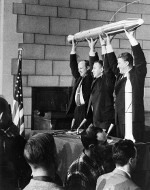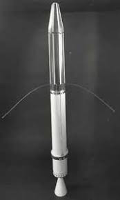A joint U.S. Army and U.S. Navy initiative called Project Orbiter launched in 1954, with the goal of putting a satellite into orbit during the International Geophysical Year, as part of a worldwide celebration that was to run parts of 1957 and parts of 1958. The timeline for the launch wasn't exactly an accelerated one. The launch of Sputnik, the Soviet Union's first satellite, changed that.
Even with a jump-start, the U.S. couldn't keep up initially with the Soviet space program. Sputnik 2 launched on Nov. 3, 1957, with the dog Laika onboard.
On Dec. 6, 1957, NASA launched a Vanguard rocket carrying Explorer. The launch was televised, and so was the explosion that engulfed the first attempt. The failure was the subject of intense inquiry, and NASA fixed the problems well enough to have a successful launch on Jan. 31, 1958. Explorer 1 was away.

Explorer I was twice the size of Sputnik and had as its basis a rocket designed by Wernher von Braun, who had worked for Nazi Germany, building rockets and missiles and other weaponry such as the dreaded V-2. Also helping design the first American satellite into space were two other prominent scientists, New Zealand native William Pickering, who later became the director of the Jet Propulsion Laboratory, and American physicist James Van Allen.

Onboard Explorer 1 was a cosmic ray detector, whose designer, Van Allen, posited that Earth was surrounded by a number of magnetic belts that prevented cosmic rays from reaching the surface. The satellite also had temperature detectors and a sound system designed to broadcast the sounds of tiny meteorites that were expected to ping off the satellite in its orbits.
In all, Explorer sent back data for four months, until its batteries ran out. It remained in orbit until 1970 and disintegrated on re-entry. It was the first of five satellites of the same name. Problems in rocketry scuttled the launches of Explorer 2 and Explorer 5. The other two reached orbit and did their scientific duty, the prime achievement of which was Explorer 3's proof of van Allen's magnetic belt theory. NASA named the belts after him.

The second American satellite in orbit was Vanguard 1, which launched on March 17, 1958. The solar-powered craft did some initial testing that NASA would later use in its Moon missions, including a three-stage launch vehicle. Vanguard 1 transmitted for seven years; it is still in orbit today.
Vanguard 2 followed, on Feb. 17, 1959, and was the first weather satellite. Later that year came Vanguard 3, going up on September 18 and achieving its primary objectives of measuring Earth's magnetic field and the effect of solar X-ray radiation on Earth's atmosphere.
The U.S. continued with its unmanned spacecraft program for many years after that. Primary among these was the Pioneer project, which early on were lunar orbiters that had varying degrees of success in reaching their targets and later on became known for interstellar launches.
Ranger was the name of another series of probes that involved the Moon. It took several attempts, but with the last four of the nine Ranger missions, NASA got its probe to land on the Moon and transmit various information back to Earth.
The Surveyor program sent seven probes to the Moon's surface, and five of them landed there–all designed to test the feasibility of what NASA hoped was a manned mission to the Moon and back.
The Mariner program sent probes to investigate Mercury, Venus, and Mars in the 1960s and early 1970s. A pair of Viking missions also went to Mars in the mid-1970s.
Mariner and Pioneer laid the groundwork for the very much well-known Voyager Project, which launched in the late 1970s and provided vast amounts of images and information about the outer solar system.
Other famous unmanned machines launched by NASA include these:
- Skylab
- Viking
 Magellan (orbit of Venus)
Magellan (orbit of Venus)- Galileo (flyby of Venus, orbit of Jupiter)
- Hubble Space Telescope
- Mars Pathfinder (first successful planetary rover)
- Cassini-Huygens (first Saturn orbiter)
- MESSENGER (first Mercury orbiter)
- New Horizons (first Pluto orbiter).